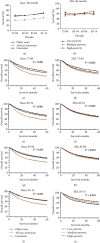Epidemiological Trends of Head and Neck Cancer: A Population-Based Study
- PMID: 34337000
- PMCID: PMC8294963
- DOI: 10.1155/2021/1738932
Epidemiological Trends of Head and Neck Cancer: A Population-Based Study
Erratum in
-
Corrigendum to "Epidemiological Trends of Head and Neck Cancer: A Population-Based Study".Biomed Res Int. 2021 Nov 24;2021:9758328. doi: 10.1155/2021/9758328. eCollection 2021. Biomed Res Int. 2021. PMID: 34869774 Free PMC article.
Abstract
Background: Over the past decades, lots of advance have occurred in the prevention, diagnosis, and treatment of head and neck cancer (HNC). However, the contemporaneous incidence and survival trends, on the basis of population-based registry, have not been reported.
Methods: The HNC cancer cases were accessed from the Surveillance, Epidemiology, and End Results (SEER) database. The incidence trend was analyzed by joinpoint analysis, with the survival trend being analyzed by period analysis of relative survival rate (RSR) and Kaplan-Meier analyses. Cox regression analysis was performed to identify the prognostic factors for overall survival.
Results: The general incidence trend of HNC increases slightly, with an average annual percentage change of 0.6%, along with five fluctuating segments. The improvement of net survival over the past decades was showed by increasing 60-month RSR, from 54.1% to 56.0% to 60.9% to 66.8%, which was further confirmed by Kaplan-Meier analyses. Moreover, disparities in incidence and survival patterns can be observed in different subgroups.
Conclusion: A fluctuating incidence pattern and an ever-improving survival were observed in HNC over time.
Copyright © 2021 Kangwen Guo et al.
Conflict of interest statement
The authors declare no competing financial interests.
Figures




References
-
- Ciardiello F., Tortora G. A novel approach in the treatment of cancer: targeting the epidermal growth factor receptor. Clinical Cancer Research. 2001;7(10):2958–2970. - PubMed
MeSH terms
LinkOut - more resources
Full Text Sources
Medical
Miscellaneous

